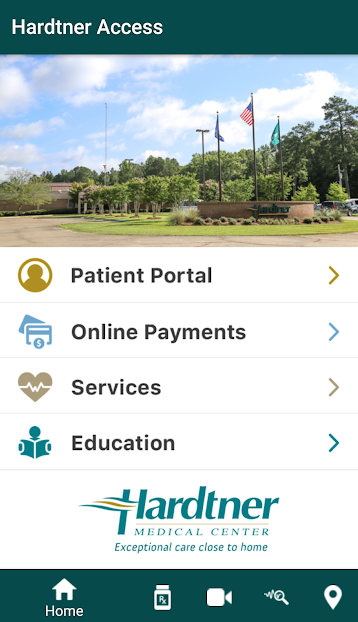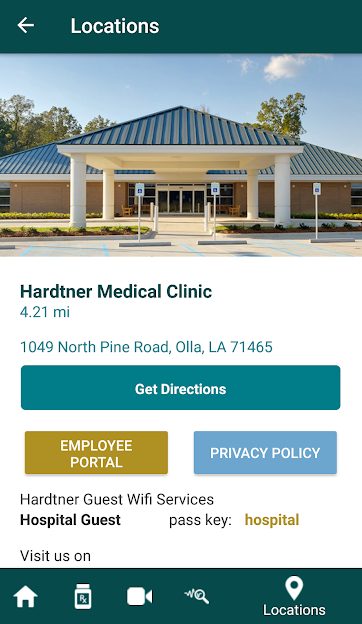Hardtner Medical Center Opens New Digital Front Door in Rural Louisiana
// By Melanie Graham //
 In early 2018, the team at Hardtner Medical Center was searching for an innovative way to engage patients and increase usage of its patient portal. It had tried emails, advertisements, flyers — even billboards.
In early 2018, the team at Hardtner Medical Center was searching for an innovative way to engage patients and increase usage of its patient portal. It had tried emails, advertisements, flyers — even billboards.
But one tactic it hadn’t tried yet was a mobile app.
“We needed to figure out a better way to promote patient interactions and we wanted to try something new,” says Shane Davis, director of information technology at Hardtner Medical Center.

Shane Davis, director of information technology at Hardtner Medical Center
Based in Olla, Louisiana, Hardtner serves the areas of Olla, Tullos, and Urania. The area is mainly rural, which was a primary factor in why Hardtner decided to pursue a mobile app.
With 35 beds and a 54-acre campus, Hardtner Medical Center includes a rehab center, imaging, family medicine, surgery center, mental health, and behavioral health services. It has a lot to offer its community, but it needed an effective way to communicate those services and improve access for patients who may not have a computer or internet.
“We know that internet isn’t always available in rural settings, but most people have smartphones,” Davis says. “We’re trying to use this technology to reach our patients wherever they may be and allow them quick access to health information and their providers.”
Improving Engagement and Access
After kicking off the project in early 2018, the Hardtner team launched its Hardtner Medical Center app in spring 2018. Within the first few months, it had more than 300 downloads across Android and iOS platforms. As of this writing, the app has had 518 sessions from 132 unique users over the past 30 days (September-October 2019), with each user spending an average of 1.44 minutes per session.
Davis and his team worked with healthcare app developer MobileSmith. The partnership was crucial to the app’s success, Davis says.
“It’s important to be able to work with a group that can devote the time and resources to make sure you’re getting the best product,” Davis says.
At the start of the app project, Hardtner formed a steering committee made up of department heads from across the medical center. The group laid out the goals of the project, conducted a search for an app vendor, and developed the app content.
The main goals of the app were to promote the patient portal, make it easy for patients to contact providers, and for patients to get more detailed information about the services Hardtner offered.
“There are a lot of things you can do with an app, but sticking to your main focus and staying true to that goal is important,” Davis says. “Don’t overwhelm yourself by trying too much at once.”

One of the main goals of the Hardtner app was to engage more patients with the patient portal, which is why it’s listed prominently on the app homepage.
The app features the patient portal prominently on its main menu, which helps patients access their medical charts and communications from their doctors.
In addition to the patient portal link, the app also includes links to:
- Online payments
- Education materials
- Location information, including maps and videos about facilities
- Prescription refills
- Services offered at Hardtner

The Hardtner mobile app includes detailed location information with maps and videos about the facilities.
Davis’ team also can send push notifications through the app to patients about events at the medical center, such as flu clinics and the annual health fair.
“It’s been well received,” Davis says. “We just recently had our annual health fair, and patients were telling us that they appreciated the notifications about the event and other educational opportunities.”
The Hardtner team does not use the new mobile app for push notifications about scheduled appointments — it uses a separate application tied to its EMR for those messages. But the app does include a link to the online portal where patients can check their messages about appointments.
To promote the new app, Hardtner sent messaging through its clinics as well as flyers around the medical center. Using a QR code was crucial in the promotion and getting patients to download the app quickly and easily, Davis says.
Partnering with a Developer

Randy Tomlin, CEO of MobileSmith
While it didn’t take long for MobileSmith to produce the initial app, Davis says the project’s steering committee took some time to study and test the features to make sure it released a top-quality product.
With the app now live, Davis keeps a regular conversation going with the MobileSmith team, which can jump on any changes or updates that Hardtner may request. Davis also has access to the MobileSmith development program, so he can schedule push notifications as needed.
In addition to apps like Hardtner’s, MobileSmith also produces “Encounter” apps, which help with pre- and post-surgery instruction and paperwork, as well as “Navigate” apps that help users find in-network providers.
“We are dedicated specifically to bringing mobile applications to the healthcare space, or what I like to call ‘the consumerization of healthcare,’” says Randy Tomlin, CEO of MobileSmith. “Consumerization is where healthcare is going — it’s where it has to go.”
Looking Ahead to New Features
A year and a half after launch, Davis’ team is starting to look at new additions it would like to roll out within the Hardtner app. Next in the queue is a wayfinding feature that will help patients better navigate to appointments and events at Hardtner Medical Center.
Davis’ team is working closely with MobileSmith to develop and test the new wayfinding feature.
“Working with them kept us focused and helped guide us so we didn’t take on too much at once,” Davis says. “Now we know how much we can really do with the app and we’re starting to focus on new ways to provide services to patients.”
Next Steps for mHealth Development
When asked about the future of mHealth and what MobileSmith has in its sights, Tomlin says the company is working to develop better mobile apps to assist remote caregivers who may be monitoring a loved one (like a parent) from another state or country.
“The caregiving space is crowded with solutions that send people to the home, but the next step is to put that onto the mobile networks,” Tomlin says. “There’s an opportunity to transform that dramatically from something that is very manual to more mobile and real-time.”
As for the mHealth space in general, Tomlin predicts the U.S. will begin to shift into a healthcare system that looks more like the banking industry today.
“All the overhead, all the brick and mortar with the U.S. healthcare system, mobile will help us remove that,” Tomlin adds. “Mobile is better — it reduces costs, it’s more relevant, and it puts the patient in charge, which is what’s desperately missing in healthcare today.”
Melanie Graham is a writer, editor, and digital strategist specializing in nonprofit and healthcare communications. She has a background in journalism, with experience in digital content marketing and social media management.
